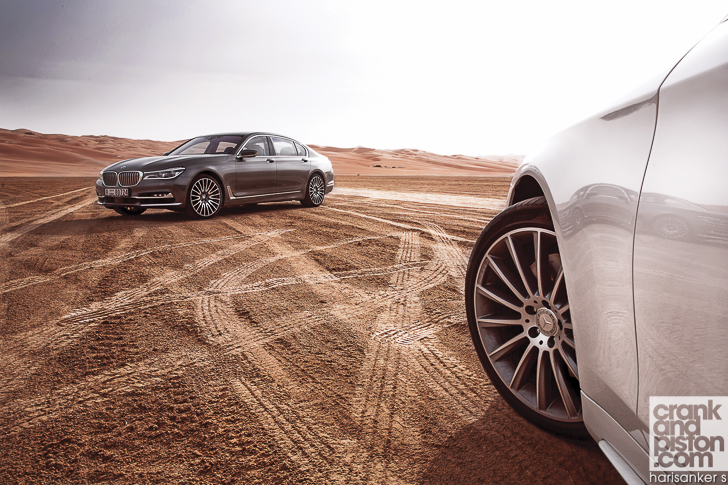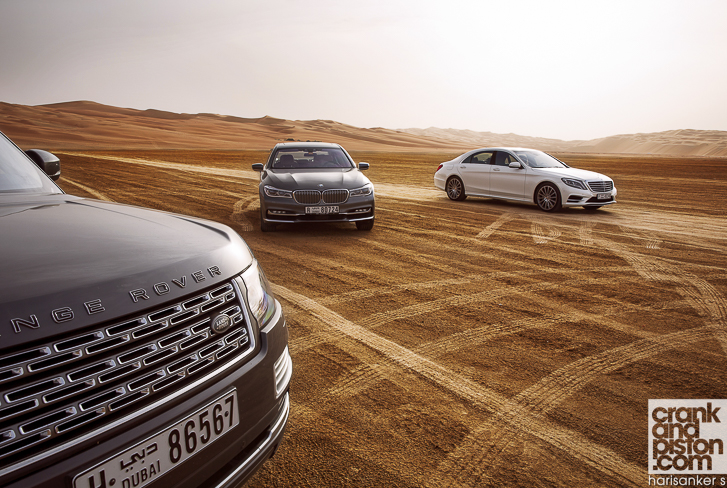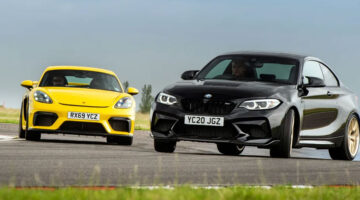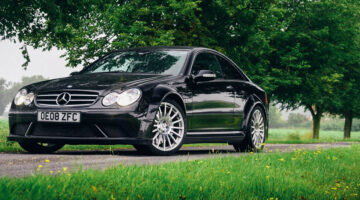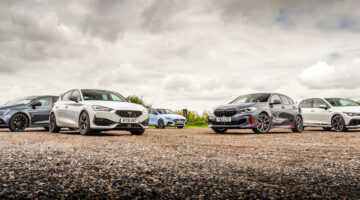| Model | Engine | Power | Torque | 0-100kph | Top speed | Weight | Basic price |
|---|---|---|---|---|---|---|---|
| Mercedes S 500 | V8, twin-turbocharged, 4663cc | 449bhp @ 5250-5500rpm | 516lb ft @ 1800-3500rpm | 4.8secs | 250kph | 2015kg (223bhp/ton) | $187,500 |
| Range Rover SV Autobiography | V8, supercharged, 5000cc | 542bhp @ 6000-6500rpm | 546lb ft @ 2500-5500rpm | 5.4secs | 225kph | 2465kg (220bhp/ton) | $244,700 |
| BMW 750Lil | V8, TwinPower Turbo, 4395cc | 444bhp @ 5500–6000rpm | 479lb ft @ 1800–4500rpm | 4.5secs | 250kph | 1990kg (223bhp/ton) | $159,200 |
HIGH RES downloadable wallpapers available HERE
In the German duo, it’s an entirely different matter. The BMW for instance houses a 444bhp 4.4-litre TwinPower Turbo V8 that spits out 516lb ft of torque and a 4.4 second 0-100kph time. Hardly slow then, and a wide torque curve means, despite the potential for turbo lag on this 1990kg land yacht, pull is ceaseless and yet, simultaneously, genteel. It’s a strong pick-up that lacks, while not the vigour, certainly the aggression of the Range Rover and the throaty V8 roar, the sensation of speed much calmer and more relaxed despite the sheer pace the 750Li is capable of. Don’t let the civility of the delivery fool you: it’s deceptively quick.
Once again though the S-Class top trumps its pretenders, the 4.7-litre V8 boasting 449bhp and 516lb ft of torque, which is delivered so smoothly you might not even realise you’ve hit 100kph in 4.8 seconds. It’s extraordinary, 449bhp delivered with neither aggression nor turbocharged peak, and yet with such grace that the refined confines of the cabin are barely rocked, the Magic Body Control continuing to float effortlessly over the faster moving ground. Once again the refinement of the S-Class is proving difficult to beat. That is until the big Merc hits the corners.
Unlike its AMG alter-ego, the sense of composure in the S-Class saloon is difficult to garner through even the longer, sweeping sections of road, weight transfer and overly inundated suspension meaning the S-Class has a tendency to roll rather than remain planted through the corners. This is hardly helped by the seven-speed gearbox, whose insistence – as we’ve seen in the past from Mercedes – to upshift and deny downshifts at key moments can prove frustrating.
“The refinement of the Mercedes S-Class is proving difficult to beat. That is until the big Merc hits the corners”
It’s not all doom and gloom though. Yes, body roll through the corners is inevitable for a vehicle 17ft long, but wider front and rear track allow a more stable base for the newly stiffened and more rigid chassis to cope with, if not contend with, lateral body movement. Similarly, steering feel leans heavily towards numb such is the effectiveness of the power-assisted steering, but fortunately the direct nature and crisp(ish) response mean there’s considerably more confidence to be had through the corners, particularly when the strong stopping power – if slightly wooden feel – through the brake pedal scrubs off speed astonishingly quickly. Sure, the S-Class saloon might not be the most ideal hoon machine on this stretch but that’s not to say the Mercedes can’t roll up its Armani shirtsleeves on occasion.

Full credit must go to BMW though, for while – like the Mercedes – it packs nearly two tonnes, the reactivity of that suspension and the rigidity of the ‘carbon core’ chassis means that the 750Li is astonishingly agile. Power is sent to all four wheels via the xDrive configuration ensuring enormous amounts of traction out of the corners. Into them, and unlike the S-Class, there’s a degree of feel and a surprising amount of heft through the steering when ‘Sport’ is selected, the very action of which lowers the ride height and tautens a suspension arm or two. Body roll then, even at ‘impressive’ speeds, is rarely a factor, and while it’s not completely eradicated, there’s such a strong sense of composure through the corners that grabbing the 7 Series by the scruff of the neck is genuinely engaging. All without the ride comfort being affected.
Which brings us to the Range Rover. Though the SV Autobiography boasts the same engine and transmission as the SVR, the same performance-focused suspension and chassis tweaks have not made their way across. What we are met with though is not a soggy bag of understeer we might reasonably have expected from a 7ft tall SUV. Granted, lean in the cabin is still a matter to contend with through the tighter and more sweeping turns, but such is the rigidity of the chassis and the tautness of the non-SVR suspension that there is a measurable sense of composure through the turns.
“The SV Autobiography is a stunning example of luxury driving, but against the 7 Series and S-Class – two models designed exclusively for the task – it falls short”
This surprising turn of events goes deeper when we consider the handling. There’s considerably more heft at the helm of the Range Rover than either German saloon – understandable given the weight – but also considerably more feel, allowing for much crisper and direct feedback from the front wheels than an SUV – and a luxury one at that – has any real right to. Range Rover’s superlative four-wheel drive system also means that traction out of the corners is beyond biblical, combining with that aggressive bank of power and strong acceleration in the lower revs to ensure that while the BMW may have an edge through the corners, the British SUV is far from humiliated: even the Mercedes is put in the shade by the SV Autobiography.
The only slight bone of contention is the threat of understeer. Textured though feedback is through the hefty steering, the sheer amount of weight balancing over the front axle, plus the almost insane amount of speed you’re able to take into the corners, means the front wheels can only take so much, despite the immensely grippy tyres: be too brave on corner entry and you may find the front end starting to sluice wide.
It’s a niggle at best though, for while the Range Rover can’t quite match the BMW for dynamic prowess, it’s easily the match – and even, possibly, better than – the S-Class. Which brings back to one of our two original questions. Time for a decider. Is the Range Rover’s place alongside the BMW and Mercedes as a genuine luxury limousine validated?
Absolutely. True, the floating nature of the ride quality might not be on par with the BMW and certainly not with the Mercedes, while the ferociousness of that V8 power output does rankle the SV Autobiography’s civility considerably. There’s little denying that, as a luxury model, Range Rover’s top spec model offers a considerable amount of bang for an equally considerable amount of buck, given the build quality and top drawer design available in the cabin, as well as the prestige that comes with the badge. Road and wind noise are restrained to a mere burble, and though the ride might not pass German saloon muster, it’s no less effective. Throw in composed driving dynamics and genuine off-road capability, and you have a luxury model that offers the best of one world and a commendable pursuit of the others.
But is it the best luxury limousine here today? Not quite. For all of the above, the SV Autobiography is a stunning example of luxury driving, but against the 7 Series and S-Class – two models designed exclusively for the task – it falls short.
So then, BMW or Mercedes? It’s tempting – VERY tempting – to side with the 7 Series. Unlike its previous iterations, the new model encompasses not only an exceptional ride quality, faultless build quality and an innovative myriad of driver assistance systems, but also sharper handling and a genuinely brilliant agility that few cars of its size have any right to boast, and even some smaller models would have a hard time bettering. But much like the Range Rover, in improving its capabilities in one area, BMW has left us short-changed in another. The cabin, still beautifully designed, is still too overly-complex, the focus leaning more towards those in the front than those in the back, which surely no self-respecting executive limousine could abide.
Which leaves the S-Class. Yes, the BMW is elegant, sophisticated and very chuckable, but compared with the S-Class, it lacks the effortless refinement and pulse-lowering luxury so entrenched in Mercedes’ flagship model. Despite its comparative lack of agility, I find myself considering ‘the limousine’, a model designed to cruise both quickly and without fuss from destination to destination, the elegance on the inside mirrored by the dignity of its prowess on the road. It’s a package Mercedes has been steadily perfecting with the S-Class for more than four decades, and which other manufacturers – despite how close they might get – haven’t quite managed to replicate just yet.
Turns out if you’re in the market for an executive limousine, you really should choose a Mercedes-Benz S-Class.
Technical specifications available on page 3
HIGH RES downloadable wallpapers available HERE

